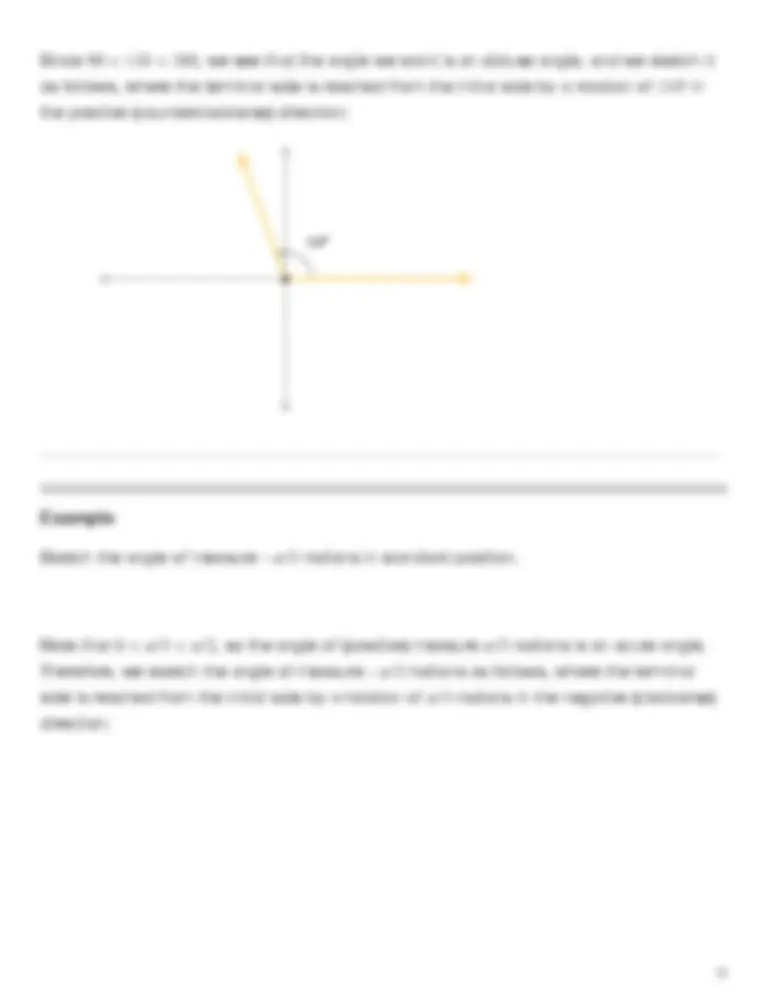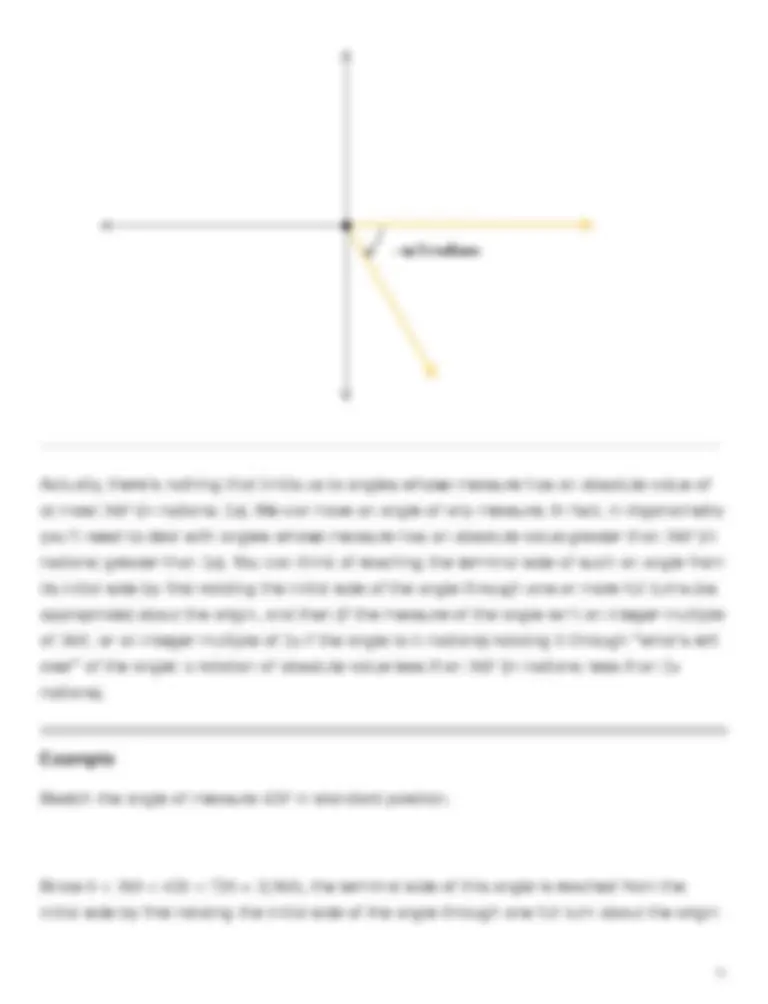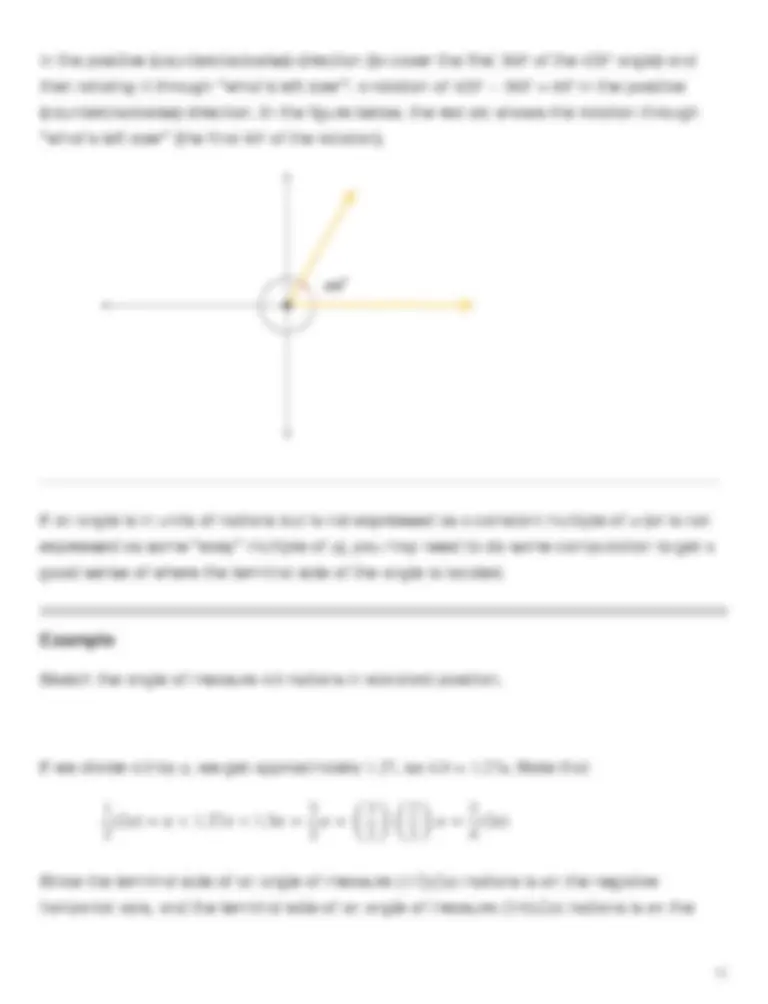





Study with the several resources on Docsity

Earn points by helping other students or get them with a premium plan


Prepare for your exams
Study with the several resources on Docsity

Earn points to download
Earn points by helping other students or get them with a premium plan
Community
Ask the community for help and clear up your study doubts
Discover the best universities in your country according to Docsity users
Free resources
Download our free guides on studying techniques, anxiety management strategies, and thesis advice from Docsity tutors
How to sketch angles in standard position on a coordinate system, defining the initial and terminal sides, and discussing the concept of positive and negative angles. It also covers the case of angles with measures greater than 360 degrees or 2π radians, providing examples and visualizations.
What you will learn
Typology: Study notes
1 / 6

This page cannot be seen from the preview
Don't miss anything!




Although an angle can be drawn at any position and in any orientation in two-dimensional space, in trigonometry it is often convenient to draw an angle on a coordinate system (an origin, and a pair of coordinate axes that are perpendicular to each other). We think of one side of the angle as the initial side and the other side of the angle as the terminal side. When we draw the angle in what is known as standard position, we put its vertex at the origin, and we draw the initial side of the angle along the positive horizontal axis. Then we think of getting from the initial side of the angle to the terminal side of the angle by rotating the initial side about the origin until it coincides with the terminal side. The amount of that rotation corresponds to the measure of the angle. Now you may be wondering what happens if one person thinks of making the rotation in the clockwise direction and someone else thinks of making the rotation in the counterclockwise direction. Doesn't that mean that the angle has two different measures? To deal with that potential source of confusion, we indicate the measure of any angle by a real number: the size of the angle (which is nonnegative) and (if the size is nonzero) the direction of the angle (indicated by including a minus sign if the rotation described above is in the clockwise direction). If your intended angle is the one whose terminal side is reached by rotating the initial side in the counterclockwise direction, the measure of the angle is positive.
If your intended angle is the one whose terminal side is reached by rotating the initial side in the clockwise direction, the measure of the angle is negative.
Sketch the angle of measure 110 ∘ in standard position.
Actually, there's nothing that limits us to angles whose measure has an absolute value of at most 360 ∘ (in radians: 2 π ). We can have an angle of any measure. In fact, in trigonometry you'll need to deal with angles whose measure has an absolute value greater than 360 ∘ (in radians: greater than 2 π ). You can think of reaching the terminal side of such an angle from its initial side by first rotating the initial side of the angle through one or more full turns (as appropriate) about the origin, and then (if the measure of the angle isn't an integer multiple of 360 ∘ , or an integer multiple of 2 π if the angle is in radians) rotating it through “what's left over” of the angle: a rotation of absolute value less than 360 ∘ (in radians: less than 2 π radians).
Sketch the angle of measure 420 ∘ in standard position. Since 0 < 360 < 420 < 720 = 2 ( 360 ), the terminal side of this angle is reached from the initial side by first rotating the initial side of the angle through one full turn about the origin
in the positive (counterclockwise) direction (to cover the first 360 ∘ of the 420 ∘ angle) and then rotating it through “what's left over”: a rotation of 420 ∘ − 360 ∘ = 60 ∘ in the positive (counterclockwise) direction. In the figure below, the red arc shows the rotation through “what's left over” (the final 60 ∘ of the rotation). If an angle is in units of radians but is not expressed as a constant multiple of π (or is not expressed as some “easy” multiple of π ), you may need to do some computation to get a good sense of where the terminal side of the angle is located.
Sketch the angle of measure 4.0 radians in standard position. If we divide 4.0 by π , we get approximately 1.27, so 4.0 ≈ 1.27 π. Note that 1 2 ( 2 π ) = π < 1.27 π < 1.5 π =
π = (
π =
( 2 π ) Since the terminal side of an angle of measure ( 1 / 2 )( 2 π ) radians is on the negative horizontal axis, and the terminal side of an angle of measure ( 3 / 4 )( 2 π ) radians is on the